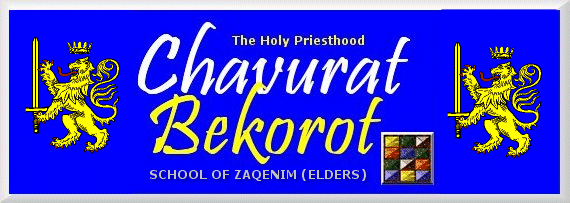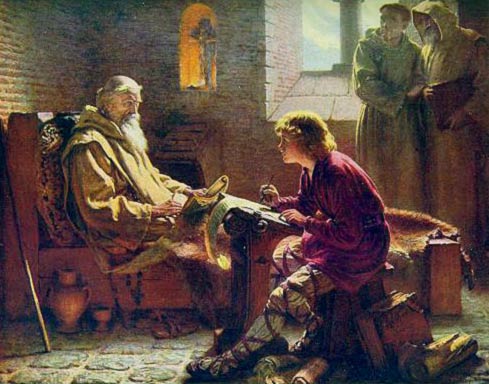
 16
JOHANNINE ESSAYS
16
JOHANNINE ESSAYS
 The Resurrection Narratives
The Resurrection Narratives
and the Person of Yah'shua
(10 May 1983)
by Christopher C. Warren, M.A.(Oxon)

Intro | 1 | 2 | 3 | 4 | 5 | 6 | 7 | 8 | 9 | 10 | 11
12 | 13 | 14 | 15 | 16 | 17 | 18 | 19 | 20 | 21
Throughout the Fourth Gospel we read of miracles performed by Yah'shua (Jesus) that are meant to show that he is the Son of Elohim (God) who offers life to men. Right at the beginning of the Gospel He is affirmed to be the Word (Heb. Dabar, Aram. Memra, Gk. Logos) (Jn.1:14.17). Although this technical term does not recur in John, it is plain that the rest of the Gospel is an exposition and justification of the doctrine that the Word became flesh. The use of 'Word' is singularly happy, for by it John was able to speak to Judatites (Jews) who had already taken some steps towards regarding Yahweh's creative Word (Ps.33:6) as in some cases a separate being from Yahweh (cp. The figurative description of 'Wisdom' in Prov.8:22ff. which is the female equivalent or Ruach haQodesh/Holy Spirit), to believers who preached the Word of Elohim (God) as the principle of order and rationality in the universe (popular Stoicism). But what John says goes far beyond anything that has previously been said.
The second revelation on the person of Yah'shua (Jesus) is that He is the Messiah from the house of David awaited by the Judahites (Jews) (Jn.7:42). In fact, the great question for the Judahites (Jews) is whether Yah'shua (Jesus) is the Messiah (Jn.7:26ff; 10:24), and the confession of the disciples is that this is precisely who He is (Jn.1:41; 4:29; 11:27; 20:31).
The third revelation on His person is that He is the Son of Man. This term is the key to Yah'shua's (Jesus') understanding of Himself in the Synoptic gospels, where it is connected with three ideas, the 'hiddenness' of His Messiahship, the necessity of His suffering, and His function as judge at the Parousia (Second Coming). These ideas are latent in John (cp. Jn.12:34; 3:14; 5:27), but the emphasis falls on the two ideas that the Son of Man has been sent from heaven as the revealer of Elohim (God) and the Saviour (Deliverer) of men (Jn.3:13; 9:35) and that He is glorified by being "lifted up" to die (Jn.12:23-24).
The fourth revelation of Yah'shua's (Jesus') person is that He is the Son of Elohim (God). This is probably Yah'shua's (Jesus') most important title in John. Since the heart of the Gospel is that Elohim (God) sent His Son as Saviour (Deliverer, Rescuer, Redeemer) (Jn.3:16), John's purpose is to lead the reader to recognise the claim of Yah'shua (Jesus) (Jn.19:7) and make the confession of the disciples (Jn.1:34,39; 11:27) that His the Son of Elohim (God). As Son, He reveals the Father Yahweh (Jn.1:18), whose activities of life-giving and judgement He shares (Jn.5:19-29). Through belief in Him men receive salvation (Jn.3:36) and freedom (Jn.8:36).
But to say that Yah'shua (Jesus) is the Son of Elohim (God) is to reveal a fifth aspect of His person, namely His deity. Thus He who as the Word of Elohim (God) is Himself Elohim (God) (Jn.1:1), is also confessed by men on earth as Master (Lord) and Elohim (God) (Jn.20:28), which is the climax of the Gospel (cp. also Jn.1:18, "No one has ever seen Elohim (God); the only Son [1], who is in the bosom of the Father, he has made Him known").
So to what extent do the resurrection narratives add to the Johannine view of the person of Yah'shua (Jesus)? Throughout his Gospel, John has in mind the difficult yet important problem of the relationship of "seeing" to "believing". The six great signs which Yah'shua (Jesus) wrought all made demands upon the sight of men; and what they saw different considerably. Some would see an event within the framework of space and time, or ordinary human experience, and indeed (and inevitably) recognise it as miraculous, and yet never see the reality of what went on. So it is that on the day after the feeding of the five thousand Yah'shua (Jesus) said to the crowds who found Him: "You seek Me, not because you saw signs, but because you ate your fill of the loaves" (Jn.6:26). All the signs posed this sort of issue to the human spirit, not least the sign of the resurrection.

Friends and enemies alike knew (and neither party ever had grounds for revising their judgements) that the crucifixion had removed Yah'shua (Jesus) from the realm of visible historical persons. Without seeing Him, His enemies thought, there would be a stop to belief in Him. So what part did the empty tomb and the appearances of the glorified Master (Lord) play in the final formation and perpetuation of Christian belief in the person of Yah'shua the Messiah (Jesus Christ) as Son of Elohim (God) and Saviour (Deliverer)?
The answer is not that the empty tomb confirmed His removal from the visible world of historical persons, and that, nevertheless, the resurrection appearances restored Him to the world. It is rather that they provided a very limited period of transition between complete historical visibility and complete historical invisibility, during which it became possible for the apostles to learn that though their Master (Lord) had never been identical with visible experience of His physical presence, was made possible in a new way at a time when visual experience of His historical person had ceased to be possible. The function of the visual experiences of the appearances of the glorified Master (Lord) to His disciples was to enable them to identify the new set of experiences of His fellowship with them with the old set of experiences when He was visible. Once the identity had been recognised between the Yah'shua (Jesus) of the earthly ministry and the glorified Master (Lord) of the Messianic Community's (Church's) life, then the particular set of resurrection experiences could and did cease. If Christianity remains an historical religion it is because it is anchored in those events which John relates at the end of his Gospel as the final act of the seventh sign.
A good deal of the material of chapter 20 is peculiar to John. Yet it would not be right to conclude that the evangelist is really saying anything different from what the Synoptists say, or is trying to report different events. In spite of considerable differences between the narratives of the four gospels as they relate to the resurrection, there is quite remarkable unanimity of testimony to the central events that happened and as to the persons concerned in them. But John, as always, is not here concerned simply to repeat the Synoptic tradition, but rather to present it in his own perspective. His chief concern in writing of this last sign is to assure believers of the future, who were unable to be present with Yah'shua (Jesus) and the apostles at the time of its enactment, that they are nevertheless fully able to share in it in the only way that matters, indeed in the veritable apostolic manner - as those who believe in Yah'shua the Messiah (Jesus Christ), the Son of Elohim (God).
Thus it is true to say that the resurrection narratives add nothing to the Johannine view of the person of Yah'shua (Jesus). However, it could be argued that the resurrection narratives add 'solidity' to Yah'shua's (Jesus') 'fleshiness' for the risen Messiah (Christ) can be touched, cooks, eats, and appears out of the air. But beyond that the message of John remains unchanged -- Yah'shua (Jesus) is still the same person he preached in the opening of his Gospel prologue. Thus the resurrection narratives confirm rather than add.
Endnotes
[1] The oldest Gk. MSS have "Elohim (God)" here though many Gk. MSS have "Son" as does the Old Syriac.
Intro | 1 | 2 | 3 | 4 | 5 | 6 | 7 | 8 | 9 | 10 | 11
12 | 13 | 14 | 15 | 16 | 17 | 18 | 19 | 20 | 21


This page was created on 1 March 2004
Updated on1 March 2004
Copyright © 1987-2008 NCCG - All Rights Reserved



